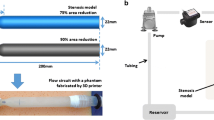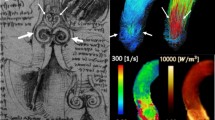Abstract
Recently, time-resolved 3D phase contrast magnetic resonance imaging, which is also called 4D flow MRI or 4D PC-MRI, has been widely utilized to investigate spatial and temporal variations in the hemodynamic characteristics of blood flows. The conventional 4D flow MRI only provides the ensemble-averaged mean flow information but misses flow fluctuation because of turbulence. There have been some new manners for turbulence quantification of the blood flow using 4D flow MRI to acquire the fluctuation intensity of the turbulent flow. Although the previous studies showed that a minimum of six flow encoding is needed to perfectly describe six independent components of the 3 × 3 symmetric Reynolds stress tensor, the optimum flow encoding scheme for turbulence has not been clearly revealed. In this study, we compared and evaluated the uncertainty of mean velocity and Reynolds stress tensor in 4D flow MRI with various flow encoding schemes. The results showed that six- to fifteen-direction measurements could result 29–51% less noise in the velocity field and 34–57% less noise in the TKE field. In addition, higher number of flow encoding had less noise in Reynolds stress estimation.
Graphical abstract











Similar content being viewed by others
References
Bammer R, Hope TA, Aksoy M, Alley MT (2007) Time-resolved 3D quantitative flow MRI of the major intracranial vessels: initial experience and comparative evaluation at 1.5 T and 3.0 T in combination with parallel imaging. Magn Reson Med 57:127–140
Barker AJ et al (2012) Bicuspid aortic valve is associated with altered wall shear stress in the ascending aorta. Circ Cardiovasc Imaging 5:457–466
Bissell MM et al (2013) Aortic dilation in bicuspid aortic valve disease flow pattern is a major contributor and differs with valve fusion type. Circ Cardiovasc Imaging 6:499–507
Brown RW, Cheng Y-CN, Haacke EM, Thompson MR, Venkatesan R (2014) Magnetic resonance imaging: physical principles and sequence design. Wiley, New York
Casas B, Lantz J, Dyverfeldt P, Ebbers T (2016) 4D flow MRI-Based pressure loss estimation in stenotic flows: evaluation using numerical simulations. Magn Reson Med 75:1808–1821
Cibis M, Jarvis K, Markl M, Rose M, Rigsby C, Barker AJ, Wentzel JJ (2015) The effect of resolution on viscous dissipation measured with 4D flow MRI in patients with Fontan circulation: evaluation using computational fluid dynamics. J Biomech 48:2984–2989
Donati F, Figueroa CA, Smith NP, Lamata P, Nordsletten DA (2015) Non-invasive pressure difference estimation from PC-MRI using the work-energy equation. Med Image Anal 26:159–172
Dyverfeldt P, Sigfridsson A, Kvitting JPE, Ebbers T (2006) Quantification of intravoxel velocity standard deviation and turbulence intensity by generalizing phase-contrast MRI. Magn Reson Med 56:850–858
Dyverfeldt P, Kvitting JPE, Sigfridsson A, Engvall J, Bolger AF, Ebbers T (2008) Assessment of fluctuating velocities in disturbed cardiovascular blood flow: in vivo feasibility of generalized phase-contrast MRI. J Magn Reson Imaging 28:655–663
Dyverfeldt P, Gårdhagen R, Sigfridsson A, Karlsson M, Ebbers T (2009) On MRI turbulence quantification. Magn Reson Imaging 27:913–922
Dyverfeldt P, Hope MD, Tseng EE, Saloner D (2013) Magnetic resonance measurement of turbulent kinetic energy for the estimation of irreversible pressure loss in aortic stenosis. JACC: Cardiovascular Imaging 6:64–71
Ebbers T, Wigström L, Bolger AF, Engvall J, Karlsson M (2001) Estimation of relative cardiovascular pressures using time-resolved three-dimensional phase contrast MRI. Magn Reson Med 45:872–879
Fisher AB, Chien S, Barakat AI, Nerem RM (2001) Endothelial cellular response to altered shear stress. Am J Physiol Lung Cell Mol Physiol 281:L529–L533
Groen HC et al (2007) Plaque rupture in the carotid artery is localized at the high shear stress region a case report. Stroke 38:2379–2381
Gülan U, Binter C, Kozerke S, Holzner M (2017) Shear-scaling-based approach for irreversible energy loss estimation in stenotic aortic flow—an in vitro study. J Biomech 56:89–96
Ha H et al (2016a) Turbulent kinetic energy measurement using phase contrast MRI for estimating the post-stenotic pressure drop: in vitro validation and clinical application. PLoS ONE 11:e0151540
Ha H et al (2016b) Assessment of turbulent viscous stress using ICOSA 4D Flow MRI for prediction of hemodynamic blood damage. Sci Rep 6:39773
Ha H, Lantz J, Ziegler M, Casas B, Karlsson M, Dyverfeldt P, Ebbers T (2017) Estimating the irreversible pressure drop across a stenosis by quantifying turbulence production using 4D flow MRI. Sci Rep 7:46618
Ha H et al (2018) Age-related vascular changes affect turbulence in aortic blood flow. Front Physiol 9:36
Haraldsson H et al (2017) Assessment of Reynolds stress components and turbulent pressure loss using 4D flow MRI with extended motion encoding. Magn Reson Med 79:1962–1971
Harloff A et al (2009) 3D blood flow characteristics in the carotid artery bifurcation assessed by flow-sensitive 4D MRI at 3T. Magn Reson Med 61:65–74
Harloff A et al (2010) In vivo assessment of wall shear stress in the atherosclerotic aorta using flow-sensitive 4D MRI. Magn Reson Med 63:1529–1536
Hasan KM, Parker DL, Alexander AL (2001) Comparison of gradient encoding schemes for diffusion-tensor MRI. J Magn Reson Imaging 13:769–780
Hsiao A, Tariq U, Alley MT, Lustig M, Vasanawala SS (2015) Inlet and outlet valve flow and regurgitant volume may be directly and reliably quantified with accelerated, volumetric phase-contrast MRI. J Magn Reson Imaging 41:376–385
Kim GB, Ha H, Kweon J, Lee SJ, Kim Y-H, Yang DH, Kim N (2015) Post-stenotic plug-like jet with a vortex ring demonstrated by 4D flow MRI. Magn Reson Imaging 34:371–375
Krittian SB et al (2012) A finite-element approach to the direct computation of relative cardiovascular pressure from time-resolved MR velocity data. Med Image Anal 16:1029–1037
Ku DN, Giddens DP, Zarins CK, Glagov S (1985) Pulsatile flow and atherosclerosis in the human carotid bifurcation. Positive correlation between plaque location and low oscillating shear stress. Arterioscler Thromb Vasc Biol 5:293–302
Lustig M, Donoho DL, Santos JM, Pauly JM (2008) Compressed sensing MRI. IEEE Signal Process Mag 25:72–82
Markl M, Wallis W, Brendecke S, Simon J, Frydrychowicz A, Harloff A (2010) Estimation of global aortic pulse wave velocity by flow-sensitive 4D MRI. Magn Reson Med 63:1575–1582
Markl M, Kilner PJ, Ebbers T (2011a) Comprehensive 4D velocity mapping of the heart and great vessels by cardiovascular magnetic resonance. J Cardiovasc Magn Reson 13:1–22
Markl M, Kilner PJ, Ebbers T (2011b) Comprehensive 4D velocity mapping of the heart and great vessels by cardiovascular magnetic resonance. J Cardiovasc Magn Reson 13:7
Markl M, Frydrychowicz A, Kozerke S, Hope M, Wieben O (2012a) 4D flow MRI. J Magn Reson Imaging 36:1015–1036
Markl M, Wallis W, Strecker C, Gladstone BP, Vach W, Harloff A (2012b) Analysis of pulse wave velocity in the thoracic aorta by flow-sensitive four-dimensional MRI: reproducibility and correlation with characteristics in patients with aortic atherosclerosis. J Magn Reson Imaging 35:1162–1168
Morbiducci U et al (2009) vivo quantification of helical blood flow in human aorta by time-resolved three-dimensional cine phase contrast magnetic resonance imaging. Ann Biomed Eng 37:516–531
Morbiducci U, Ponzini R, Rizzo G, Biancolini ME, Iannaccone F, Gallo D, Redaelli A (2012) Synthetic dataset generation for the analysis and the evaluation of image-based hemodynamics of the human aorta. Med Biol Eng Comput 50:145–154
Pelc NJ, Bernstein MA, Shimakawa A, Glover GH (1991) Encoding strategies for three-direction phase-contrast MR imaging of flow. J Magn Reson Imaging 1:405–413
Petersson S, Sigfridsson A, Dyverfeldt P, Carlhäll CJ, Ebbers T (2015) Retrospectively gated intracardiac 4D flow MRI using spiral trajectories. Magn Reson Med 75:196–206
Pope SB (2001) Turbulent flows. IOP Publishing, Bristol
Slager C, Wentzel J, Gijsen F, Thury A, Van der Wal A, Schaar J, Serruys P (2005) The role of shear stress in the destabilization of vulnerable plaques and related therapeutic implications. Nat Clin Pract Cardiovasc Med 2:456–464
Uretsky S, Gillam LD (2013) “ Nature vs. Nurture” in Bicuspid aortic valve aortopathy: more evidence that altered hemodynamics may play a role. Circulation. https://doi.org/10.1161/circulationaha.1113.007282
von Spiczak J, Crelier G, Giese D, Kozerke S, Maintz D, Bunck AC (2015) Quantitative analysis of vortical blood flow in the thoracic aorta using 4D phase contrast MRI. PLoS ONE 10:e0139025
Zwart NR, Pipe JG (2013) Multidirectional high-moment encoding in phase contrast MRI. Magn Reson Med 69:1553–1563
Acknowledgement
This research was supported by the Basic Science Research Program through the National Research Foundation of Korea (NRF), funded by the Ministry of Education (2018R1D1A1A02043249). This study was supported by 2018 Research Grant (PoINT) from Kangwon National University.
Author information
Authors and Affiliations
Corresponding author
Additional information
Publisher's Note
Springer Nature remains neutral with regard to jurisdictional claims in published maps and institutional affiliations.
Rights and permissions
About this article
Cite this article
Ha, H., Park, H. Comparison of turbulent flow measurement schemes for 4D flow MRI. J Vis 22, 541–553 (2019). https://doi.org/10.1007/s12650-019-00556-7
Received:
Revised:
Accepted:
Published:
Issue Date:
DOI: https://doi.org/10.1007/s12650-019-00556-7




